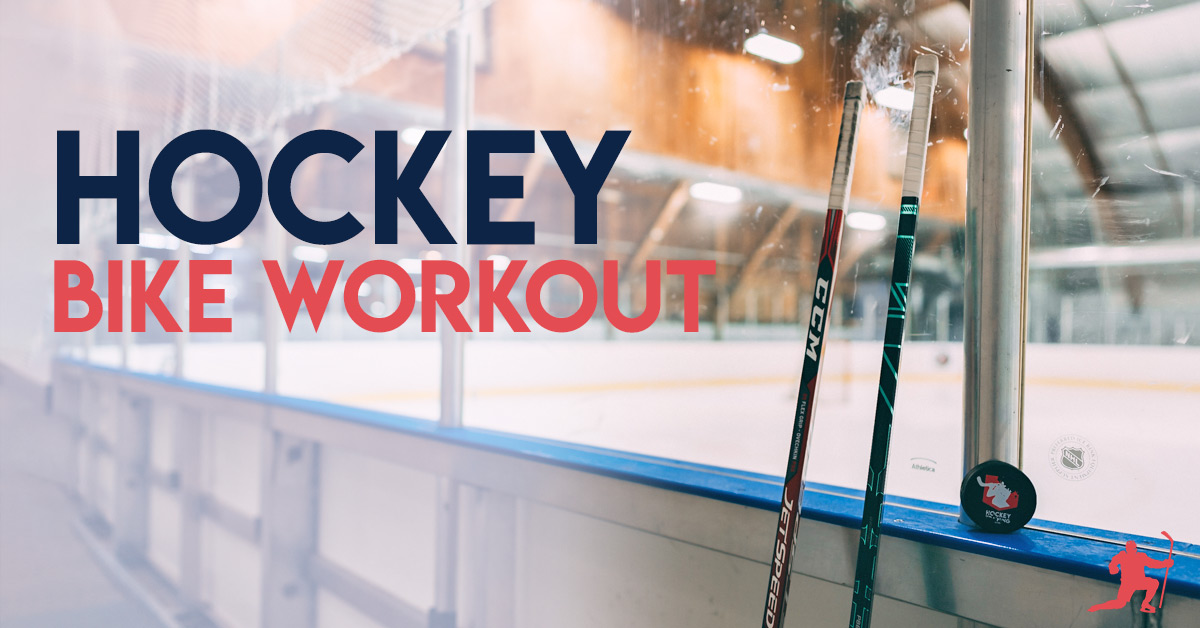In this article, I’m going to show you the best hockey workout you can do on a stationary bike.
Look, I’ll say it right out of the gates, I like sprinting the best for hockey athletes.
The correlations I have seen from improvements in sprinting speed to improvements in on-ice skating speed are indisputable.
Sprinting is something you’ll often see in the programs here at Hockey Training and for many good reasons too.
But, you can’t always sprint.
Some athletes have ankle, knee, or hip problems that are sidelining them from the high-impact nature of running.
Some athletes have plantar fasciitis, which completely derails their running for weeks or even months on end.
And finally, some hockey players don’t have the space (or the weather) to accommodate for sprinting year-round.
I wanted to write this article today to give you one more tool in your tool kit to improve your hockey performance if a bike is all you have access to.
Using Interval Training To Our Advantage
When you review the scientific research on high-intensity interval training (HIIT), you’ll see a lot of talk about something called “VO2 max.”
You’ll also frequently hear about these VO2 Max measurements being done on NHL athletes to see where their current level of fitness is at.
Put simply, your body’s VO2 max is a measurement of the maximum volume of oxygen that it can use at any one time, and it’s a major factor in determining your endurance level.
The tough part here is that the research has clearly shown that you should ideally be achieving 80-100% of your VO2 max during an interval workout in order to reap all of the benefits from the training.
That’s good to know from an information standpoint. However, it’s not too practical because unless you’re in a lab, you can’t measure your VO2 during training.
(There are estimates available, but they aren’t very reliable.)
Fortunately, hockey players can also work with a more useful and practical metric known as their Vmax.
Breaking it down to simple terms, you’ve reached your Vmax level of exertion when you feel you can’t bring in as much oxygen as your body wants to sustain the activity (you shouldn’t be able to hold a conversation at all, it should be very labored breathing).
For most people, this is around 90% of their subjective all-out effort.
Hockey Players Need To Maintain Their Vmax
In your hockey bike workout, you need to exert enough effort to be at or above 90% of your Vmax, and ideally, even your rest periods shouldn’t allow you to achieve complete and total recovery from oxygen debt.
As I’m sure you can predict, this means you need to go as fast as possible.
This is not an easy training session.
Your primary goal is to repeat this effort many times over as the research also indicates that the longer period of time you spend in this “max zone” across the duration of a workout, the greater the benefits will be.
The workout format takes some nuanced understanding to put it together properly and make it hockey-specific (we will get to an example workout shortly).
Important Considerations
Interval training offers a very well-established route that hockey players can use to maximize fat loss results and take their conditioning to the next level.
Six things should be considered before moving forward with high-intensity interval training (HIIT) in your hockey training:
#1: Sprinting is the best option if you can. I wrote about this extensively in the past on both speed and conditioning.
#2: The best types of cardio for interval work in hockey athletes with injury limitations are biking and swimming. For a swimming workout, check this out. If you have a lower-body injury using a rowing machine can also be a solid option.
#3: Due to the extremely fatiguing nature of the workout design, I don’t recommend doing these more than 2-3 times per week. Even 3x per week is really pushing it.
#4: If you would like to use interval training in a low-intensity manner to maximize aerobic training capacity (the interval training I have discussed thus far in this article is exclusively anaerobic), check this out and use the exact same protocol but with a bike.
#5: Every 5th week you should take off from all HIIT training to allow for optimal recovery and to gain all of the training adaptations you worked so hard for in the previous 4 weeks.
#6: Due to the extremely fatiguing nature of the workout design, it’s likely best placed in the off-season (unless you have a very infrequent schedule during the in-season like many Men’s League players do).
Hockey Bike Workout
- 5-Minute warm up at a light pace
- Five rounds of 15 seconds on, 15 seconds off
- 5-Minutes back at your warm up pace
- Five rounds of 30 seconds on, 30 seconds off
- 5-Minute cool down
Your “on” pace would be a 90%+ effort (nearly all-out), while the “off” pace would just be light pedaling instead of fully resting.
And that’s it!
If you want to increase the intensity of the workout even more, add in jump variations to every interval round.
Here’s an example:
- 5-Minute warm up at a light pace
- Five rounds of 15 seconds on, 15 seconds off, plus 3/side of split squat jumps
- 5-Minutes back at your warm up pace
- Five rounds of 30 seconds on, 30 seconds off, plus 3/side of skater bounds
- 5-Minute cool down
Final Thoughts
With limited space, equipment, or injuries, sometimes we have to get creative with our hockey program design.
But, it should never mean that you “can’t train like a hockey player” — you can ALWAYS train like a hockey player.
Doing the above hockey bike workout is an extremely effective way to get a great hockey-specific workout in (when you try it, you’ll know)!
If you want more workouts and programs to become a better hockey player, check out the Hockey Skills Accelerator, and let’s take your performance to the next level today.


Morning !
Perfect ! What I’ve been looking for !
My knee can’t take the sprinting any more !
I enjoy a good bike ride !
Great Volume of Material You Boys produce as Always !!
Stay Safe
Enjoy The Day ………..
Is this more for a normal stationary bike, or for an “Assault Bike.” Clearly an Assault Bike is more challenging than a normal stationary bike, so wanted to be clear.. Thanks!!
Hey Chris,
Yes, it would be the same guidelines regardless because it’s more about targetting a specific energy system rather than the difficulty level of the tool being used. The assault bike is going to make it much harder due to the upper body component, but, all intervals/rests are still the same 💪
I have been use my stationary bike for the last ten years to maintain elevated heart rate and For an old fella in his fifties I watch games on tv and ride hard during play and recover on whistles and commercials it helps keep an old Man ready to compete.
I haven’t been able to play hockey in over a year, but I have continued to workout (Men’s League) and I have done various cardio routines including tempo runs as advocated on this site. I thought I was in decent shape for 53 years old, but then I did this HIIT workout on my bike, and I was like, “oh man.” This is exactly what it feels like when you get on the ice and are just completely gassed after your first shift in forever. There is in shape and then there is hockey shape. I’ve got a couple of months until my season starts and I will be doing this twice a week until it gets close.
I really glad I tried it, because it revealed a huge weakness for me.
Thanks for all you do!